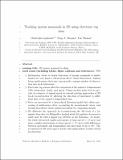Files in this item
Tracking marine mammals in 3D using electronic tag data
Item metadata
| dc.contributor.author | Laplanche, C. | |
| dc.contributor.author | Marques, Tiago A. | |
| dc.contributor.author | Thomas, Len | |
| dc.date.accessioned | 2016-04-09T23:01:39Z | |
| dc.date.available | 2016-04-09T23:01:39Z | |
| dc.date.issued | 2015-09 | |
| dc.identifier | 190336935 | |
| dc.identifier | 6b48532e-5379-4f85-abee-0c79a5419109 | |
| dc.identifier | 84941809787 | |
| dc.identifier | 000362916100002 | |
| dc.identifier.citation | Laplanche , C , Marques , T A & Thomas , L 2015 , ' Tracking marine mammals in 3D using electronic tag data ' , Methods in Ecology and Evolution , vol. 6 , no. 9 , pp. 987-996 . https://doi.org/10.1111/2041-210X.12373 | en |
| dc.identifier.issn | 2041-210X | |
| dc.identifier.other | ORCID: /0000-0002-7436-067X/work/29591665 | |
| dc.identifier.other | ORCID: /0000-0002-2581-1972/work/56861253 | |
| dc.identifier.uri | https://hdl.handle.net/10023/8591 | |
| dc.description.abstract | 1. Information about at-depth behaviour of marine mammals is fundamental yet very hard to obtain from direct visual observation. Animal-borne multisensor electronic tags provide a unique window of observation into such behaviours. 2. Electronic tag sensors allow the estimation of the animal's 3-dimensional (3D) orientation, depth and speed. Using tag flow noise level to provide an estimate of animal speed, we extend existing approaches of 3D track reconstruction by allowing the direction of movement to differ from that of the animal's longitudinal axis. 3. Data are processed by a hierarchical Bayesian model that allows processing of multisource data, accounting for measurement errors and testing hypotheses about animal movement by comparing models. 4. We illustrate the approach by reconstructing the 3D track of a 52-min deep dive of a Blainville's beaked whale Mesoplodon densirostris adult male fit with a digital tag (DTAG) in the Bahamas. At depth, the whale alternated regular movements at large speed (>1·5 m s-1) and more complex movements at lower speed (<1·5 m s-1) with differences between movement and longitudinal axis directions of up to 28°. The reconstructed 3D track agrees closely with independent acoustic-based localizations. 5. The approach is potentially applicable to study the underwater behaviour (e.g. response to anthropogenic disturbances) of a wide variety of species of marine mammals fitted with triaxial magnetometer and accelerometer tags. | |
| dc.format.extent | 1054345 | |
| dc.language.iso | eng | |
| dc.relation.ispartof | Methods in Ecology and Evolution | en |
| dc.subject | Animal movement modelling | en |
| dc.subject | Dead reckoning | en |
| dc.subject | Electronic tag | en |
| dc.subject | Flow noise | en |
| dc.subject | Hierarchical Bayesian modelling | en |
| dc.subject | Track reconstruction | en |
| dc.subject | Triaxial magnetometer and accelerometer | en |
| dc.subject | QH301 Biology | en |
| dc.subject | QL Zoology | en |
| dc.subject | DAS | en |
| dc.subject | BDC | en |
| dc.subject | R2C | en |
| dc.subject | SDG 14 - Life Below Water | en |
| dc.subject.lcc | QH301 | en |
| dc.subject.lcc | QL | en |
| dc.title | Tracking marine mammals in 3D using electronic tag data | en |
| dc.type | Journal article | en |
| dc.contributor.institution | University of St Andrews. School of Mathematics and Statistics | en |
| dc.contributor.institution | University of St Andrews. Scottish Oceans Institute | en |
| dc.contributor.institution | University of St Andrews. Centre for Research into Ecological & Environmental Modelling | en |
| dc.contributor.institution | University of St Andrews. Statistics | en |
| dc.contributor.institution | University of St Andrews. Marine Alliance for Science & Technology Scotland | en |
| dc.identifier.doi | https://doi.org/10.1111/2041-210X.12373 | |
| dc.description.status | Peer reviewed | en |
| dc.date.embargoedUntil | 2016-04-10 | |
| dc.identifier.url | http://onlinelibrary.wiley.com/doi/10.1111/2041-210X.12373/suppinfo | en |
This item appears in the following Collection(s)
Items in the St Andrews Research Repository are protected by copyright, with all rights reserved, unless otherwise indicated.

